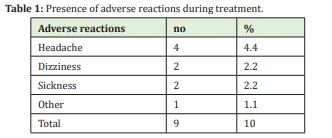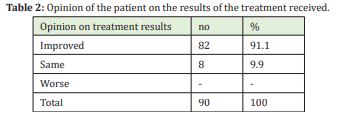Introduction: Cerebrovascular diseases are the first cause of admission for neurological disorders in Cuba.
Objectives: To determine some results in patients with Ischemic cerebrovascular disease treated with ozone.
Methodology: A prospective descriptive investigation was carried out in the General Hospital of Morón "Roberto Rodríguez Fernández", in the period between September 2019 and the same date in 2020.
Results: A total of 90 patients were included in the study, of which only 10% presented some type of adverse reaction during the treatment and 91.1% of them reported feeling improved at the end of the ozone therapy.
Conclusions: Ozone therapy proved to be safe and widely accepted by patients.
Keywords: Cerebrovascular disease, Therapeutics, Ozone therapy
It is known by the name of Cerebrovascular Disease (CVD) to the conditions that result from the temporary or permanent functional loss of any part of the Central Nervous System located in the cranial cavity, generally of sudden installation, caused by thrombotic or embolic occlusion, or due to rupture of an encephalic artery (or sometimes a vein)1 CVD is the leading cause of admission for neurological disorders, with a global annual incidence of around 800 cases per 100,000 inhabitants; in developed countries it is estimated that up to 5% of the population over 60 years of age suffers from this condition in some way. As life expectancy increases, the risks and, therefore, the prevalence increase.2,3 15% of deaths that occur between 60 and 75 years of age are due to them. They are also responsible for a vast burden of disability in the community, as 50% to 70% of those who survive are left with sequelae.4 All this, together with the long periods of hospitalization, the disabilities it produces and the costs of rehabilitation, as well as job losses due to disability, make it one of the most costly diseases, since it affects the economy of medicine, family and individual.5-7 80% of CVD cases are ischemic, atherothrombotic of large, medium or small vessels (lacunar), embolic from the heart or extra or intracranial arteries (carotid or vertebral) and hemodynamic, when factors that compromise local or systemic perfusion generate cerebral ischemia. The remaining 20% of CVD is hemorrhagic, either due to subarachnoid hemorrhage (SAH) or spontaneous intracerebral hemorrhage (ICH)8 Knowing that the population over 60 years of age increases considerably with increasing life expectancy, due to the current advances, health programs and the improvement of socioeconomic conditions, it is to be assumed that the prevalence will increase in the coming years, causing a greater number of deaths.9 Ozone is a gas whose molecule is made up of three oxygen atoms; medical ozone is a mixture of 5% ozone and 95% oxygen; its concentration is expressed in micrograms and oxygen in milliliters.10
Cerebrovascular disease due to lack of blood supply with selective disorders of the most vulnerable regions of the brain, whether persistent or temporary, carries with it a decrease in blood supply caused either by thrombosis (plugging of an artery by plaques in the wall), embolism (clots that are detached either by heart rhythm disorders or by detachment of a plaque from the arteries), increased venous pressure due to problems with drainage of the venous flow or by arteriolopathy (hardening of the walls of the small arteries).10 Ozone is beneficial by improving blood flow by increasing the oxygen content in the blood, with improved capillary blood circulation (finer arteries), thus avoiding lack of irrigation. Increases the flexibility of red blood cells thus facilitating the passage of blood through the capillaries; improves oxygen metabolism at the level of red blood cells which induces an increase in the use of glucose in brain tissue. Combats acidosis (remains of waste where there has been a lack of blood, by activating enzymes that inhibit peroxides and free radicals (both are toxic substances that destroy cells).11,12 The objective of this research is to determine some results in patients with Ischemic cerebrovascular disease treated with ozone.
A descriptive study was carried out. The study universe consisted of all the patients treated with the diagnosis of Ischemic CVD in the consultation of cerebrovascular diseases in the period between September 1, 2019 and the same date of 2020 at the provincial general teaching hospital ¨Capitán Roberto Rodríguez Fernández¨ To carry out this study, a survey was applied to all the patients participating in the research and the principle of informed consent was taken into account.
The results were given in numerical values and percentages. SPSS 15.0 was applied for data analysis. The discussion and synthesis of the research was carried out according to the proposed objectives and the results compared with other investigations on the subject, the variations found with the consulted literature were explained and conclusions were drawn.
As summary measures, absolute frequencies and percentages were used. In the development of this research, the premise was to respect the bioethical principles that are implicit in studies with human beings. All patients were asked for their consent to participate in the study. Ozone was administered rectally, in 20 sections on days from Monday to Friday at a dose of 200ml. In the consultation created for the activity in the hospital Table 1 and Table 2.


In the present study, a total of 90 patients with clinical and imaging diagnoses of ischemic cerebrovascular disease were included, treated in the consultation set up for the specialized care of these patients. In the research, patients predominated among the age group of 75 years or more, as well as the female sex.
Only in 10% of cases was some type of adverse reaction reported, all were classified as mild and in no patient was it necessary to interrupt ozone therapy. The most frequent reactions were headache, which was observed in four patients for 4.4%, as well as dizziness and nausea with 2.2% respectively.
Ozone therapy was widely accepted in patients, 91.1 reported improvement in their clinical status after application of treatment and 9.9% found no improvement with therapy, it was significant that no patient reported feeling worse later to the application of therapy.
Therapeutics is considered as a very useful complementary treatment in multiple entities, among its benefits the poor reporting of adverse reactions stands out, so it is considered a harmless therapy that has among its benefits being able to use it in conjunction with the therapy In addition, ozone administration can be suspended at the time deemed appropriate without deleterious effects for the patient.
Ischemic cerebrovascular disease is the result of the occlusion of a vessel of the cerebral circulation with the consequent decrease in perfusion and irrigation in a certain area of the brain, all of which supports the hypothesis of the usefulness of ozone therapy because It improves the levels of cerebral and systemic oxygenation, in addition to being attributed homoreological and neuroprotective properties.
The results correspond to those obtained in an investigation carried out in Cuba at the surgical clinical hospital on October 10, the benefits of this therapy were corroborated in 150 patients in the acute, subacute and chronic phases of the disease by improving the clinical, neurological and functional of the patients in whom it was applied.13
Rectal ozone therapy was found to be useful in patients with ischemic cerebrovascular disease as it was safe and widely accepted.
None.
None.
Author declares that there is no conflict of interest.
- 1. Franci AS, Braunwald E, Isselbacher KJ. Cerebrovascular diseases. In: Harrinson, Principles of Internal Medicine, Spain: Mc Graw-Hill. 2003;2645:2668–2672.
- 2. Naragán Raj K. Headinjury. In: Principles of Neurosurgery. New York: Ed Williams and Wilkens. 2016;238:259.
- 3. Pérez JR. Cerebrovascular disease Epidemiology. 2000;18(5).
- 4. Aldabe R. Atherothrombotic cerebral infarction. Rev de neuropsiquiatría del Perú. 2004;64(4):2265–2269.
- 5. Agüero MA. Mortality in the Intensive Care Service. Rev Arch Médica. 2014;10(1).
- 6. Caicoya M, Rodríguez T, Lassheras C, et al. Strokeincidence in Asturias between 1990-1991. Rev Neurol. 2015;24(131):806-811.
- 7. Caplan LR. Cerebral ischemia and intarction in black: Clinical autopsy and angiographic studies. A guide to management and prevention. New York. Korger. 2015; pp. 7–18.
- 8. Spanish Society of Arteriosclerosis. Arteriosclerosis. 2015.
- 9. Suallow CLM, Warlow CP. For the International Stroke. Incidence Collaboration Comparable studies of the incidence of stroke and its pathological types. Stroke. 2005;28:491–499.
- 10. Bruno A, Biller J, Adams HP. Acute blood glucose level and autcome from ischemic stroke: Trials of ORC 10172 in acute Stroke Treatment (TOAST) Investigators. Neurology. 2014;52:280–284.
- 11. Zarrans J. Neurology. Madrid. Harcout-Brace from Spain 2004; p. 329
- 12. Adams R, Victor M, Ropper A. Principles of Neurology. Mexico. McGraw-Hill Interamericana Ed; 2014, p. 674.
- 13. Menéndez S, González R, Ledea OE, et al. Basic aspects and clinical applications. Havana, Cuba: Editorial CENIC; 2008:10–320.

